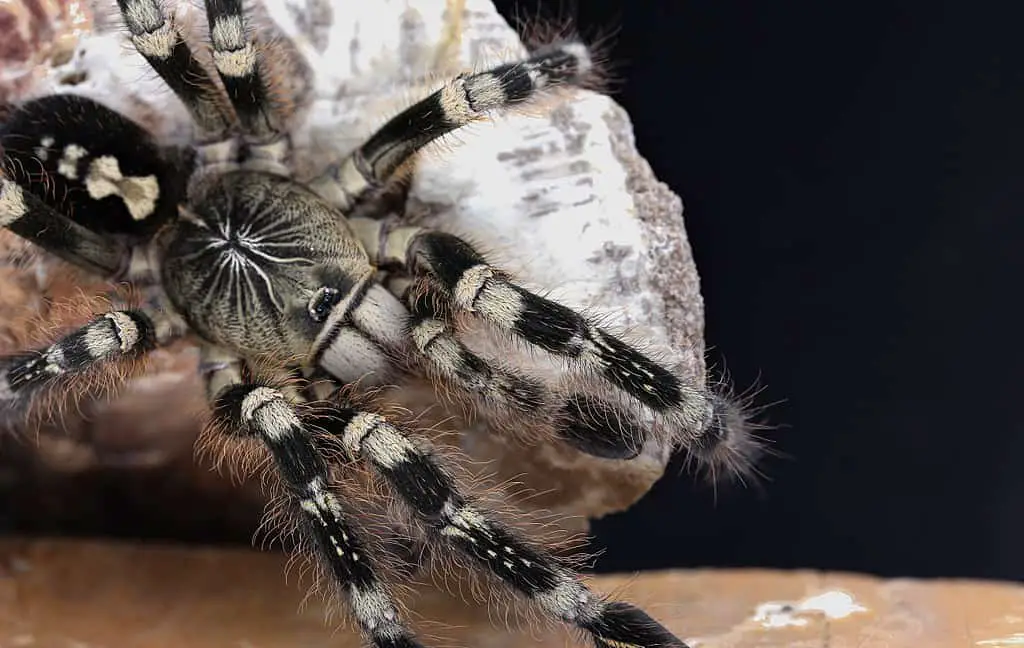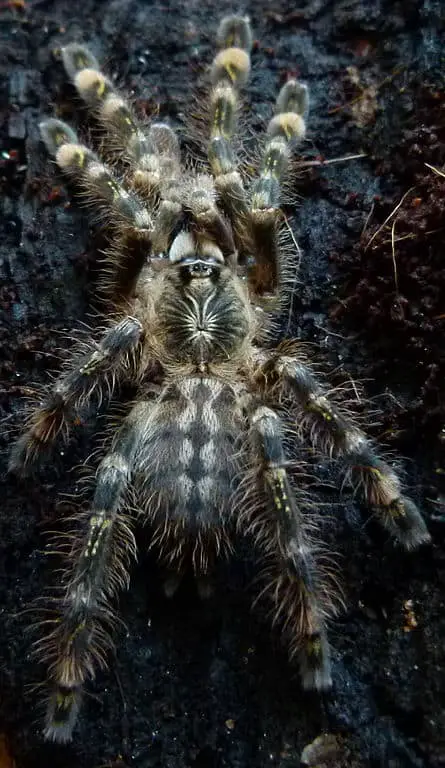The Poecilotheria subfusca, commonly known as the Ivory Ornamental tarantula, is a beautiful arboreal bird spider. Native to Sri Lanka, these Old World tarantulas are the fancy of many enthusiasts. To fall in love with these beautiful spiders, one only has to notice their distinguishing colored patterns and subtle hues.
These pokies are a rare and expensive species. Despite their skittish nature, when properly cared for, they can be a wonderful addition to the home of hobbyists.
Want to know more about caring for these amazing creatures? Keep reading and we’ll tell you all of these beautiful spider’s secrets!

Ivory Ornamental Tarantula Care Sheet
| Name of Species | Poecilotheria subfusca, previously Poecilotheria uniformis |
| Family | Theraphosidae |
| Common names | Ivory Ornamental Tarantula, Montane Tiger Spider |
| Native location | Sri Lanka |
| Category | Old World |
| Type | Arboreal |
| Body Length | Female 3″ / Male 2.5″ |
| Leg span | 6.7 inches |
| Growth speed | Fast |
| Urticating hairs | None |
| Diet | Insects, primarily roaches & crickets |
| Social | Primarily solitary, but communal living has been attempted |
| Temperature | 70 to 75 °F |
| Humidity | 65-75% |
| Life span | Females: 11-15 years / Males 3-4 years |
| Experience level | Advanced |
Ivory Ornamental Tarantula Overview

The Poecilotheria subfusca has many nicknames including Ivory Ornamental Tarantula (most common), Ivory-Billed Ornamental Tarantula, or Montane Tiger Spider.
Whatever you call them, they’re a stunning spider that has drawn the attention of hobbyists around the world.
However, while beautiful, they’re not for the faint of heart. As an Old World species, they have potent venom, are extremely quick, and have a defensive temperament.
Appearance
The Ivory Ornamental Tarantula derives its nickname from its appearance. With a dark dorsal exoskeleton, cream starburst design across its abdomen, and blond hairs covering its body, this tarantula is a beauty to behold.
Although there is no definite body length attributed to this species, the female is considerably larger with an average body length of about 3 inches while the smaller male has a body length of about 2.5 inches.
The female can be differentiated from the male by size and carapace markings.
This species is quite large, topping out at a leg span of almost 7 inches.
Variants
The Ivory Ornamental Tarantula exists in two major forms- the Highland and the Lowland.
The best way to differentiate between both forms is by studying their abdominal pattern. The Highland is smaller and has a black-filled-in tattoo on its abdomen, whereas the Lowland is larger and has an unfinished abdominal tattoo.
Behavior and Temperament
The Ivory Ornamental Tarantula is a shy and easily spooked arachnid. They do not tolerate being handled and will often run off at lightning speed if something scares them.
Due to their defensive nature, continuous provocation can result in a nasty bite from them. They bite multiple times and hang on after biting while injecting their potent venom.
The human reaction to the venom can be severe and locally painful, which is why it’s not recommended to handle this species, even if you have a lot of experience.
The Ivory Ornamental is not a good choice for the beginner or intermediate tarantula owner due to its defensive nature, lightning-fast speed, and potent venom.
Price
Due to their protected conservation status, this pokie is usually purchased at a hefty price. In captivity, the Ivory Ornamental Tarantula is limited in number. At the moment, Sri Lanka no longer allows the exportation of this species. It’s very important to buy from reputable breeders to ensure you buy a captive-bred specimen so that you do not support poachers.
The price of the Ivory Ornamental Tarantula usually depends on the variant to be purchased. The Highland form is more expensive and costs about $90-150 while the lowland form can be obtained for as low as $40.
In addition, slings are much cheaper than adults. Especially adult or sub-adult females, due to their longer lifespan are often priced on the higher end.
Caring for an Ivory Ornamental Tarantula
Tarantulas are not particularly difficult to care for. They’re very low maintenance and don’t require all that much to be happy. Provide them with a nice enclosure that has the proper temperature & humidity levels, good substrate, food, and water, and they will be able to thrive.
Tank setup
The Ivory Ornamental Tarantula, due to its arboreal origin, prefers to be above the ground. This origin should be considered in the tank setup.
For adults, the terrarium should have a length and width of at least 3 by 2 times the size of the tarantula’s leg span (about LXBXH: 10″x10″x16″ in this case) and be taller than longer.
Slings can be housed in smaller enclosures, but it’s important that you rehouse them when they grow too big.
As an arboreal species, it’s important that you provide this spider with a hollow piece of cork bark that’s placed vertically in the enclosure. This will allow them to climb and make their hide in the hollow bark.
Suitable plants may be added.
Temperature & Humidity
This tarantula requires a humidity level of about 70% and does well in temperatures between 70 and 75 °F.
Substrate
As an arboreal species, substrate is less important for them than for terrestrial spiders. Nevertheless, they still need it. Provide them with a layer that’s about as deep as the length of their body. So, if you have a 3″ female P. Subfusca, give her a layer of substrate that’s about 3 inches deep.
Good materials to use include coconut fibers, peat moss, vermiculite, or a mixture of these combined with topsoil.
The substrate should be watered at least once a month so the substrate stays moist but not drenched.
Since these spiders require high humidity to thrive, adequate ventilation is important to avoid the growth of bacteria or mold. In addition, it’s important to remove uneaten food in a timely matter.
Diet and watering
Due to their rapid growth rate, P. subfusca spiderlings have a voracious appetite. Slings are small and vulnerable and should be fed cricket legs, or flightless fruit flies.
As they grow into the juvenile stage of their life, they can start eating live prey such as small crickets and roaches.
As adults, they can eat a variety of insects, but they’re most often fed crickets and roaches. The amount to feed them depends on their size. Keep an eye on the abdomen, if it gets too large, you’re overfeeding them. If it’s shrinking, you should feed them more.
Water should be given in a large shallow water bowl, which should be refreshed frequently. Slings that are too small to drink from a bowl will drink the droplets that they find in the enclosure.
Social
People have successfully kept this species in a communal setup. However, you should only do this if you know what you’re doing. It’s very important that you give each spider enough space and food when attempting communal living to ensure that cannibalism will not occur.
Ivory Ornamental Tarantula Facts
- The Ivory Ornamental Tarantula creates an asymmetric tunnel web, mostly visible at night.
- Breeding P. subfusca in captivity is uncommon and the first-ever US breeding was in 2004. Egg sacks contain around 30 – 60 eggs.
- The Ivory Ornamental Tarantula has a dark center. This is believed to be an adaptation for rapid heat absorption in their natural habitat.
- A mutualistic relationship has been observed between frogs such as Ramanella nagaoi and this tarantula.
Final words
Tarantulae are great low-maintenance exotic pets to own. This tarantula, though beautiful, is not the right pet for everyone. It is not for beginners and should be owned only by experts to prevent injury to both humans and arachnids.
If you’re new to the hobby, you’re much better off starting with a more docile New World species such as the Antilles Pink Toe or the Mexican Red knee. That way, you can get some experience under your belt before moving on to more defensive and venomous pokies.
- How Long Do American Eskimo Dogs Live? Important Factors and Care Tips - September 29, 2023
- Do American Bulldogs Need Grooming? Essential Tips and Care Guidelines - September 29, 2023
- Do Bengal Cats Enjoy Playing? Essential Tips for Keeping Them Active - September 29, 2023